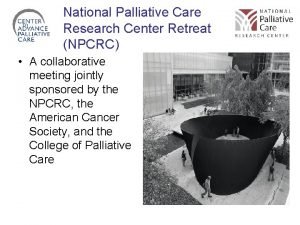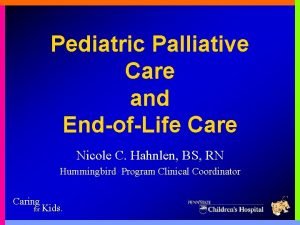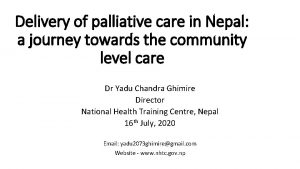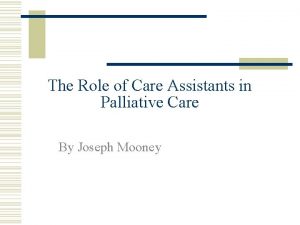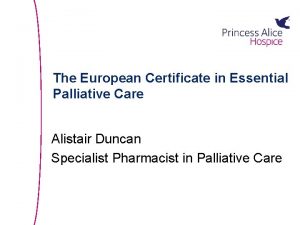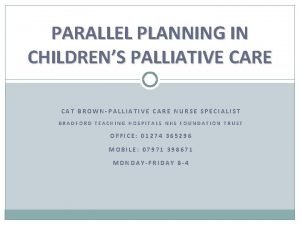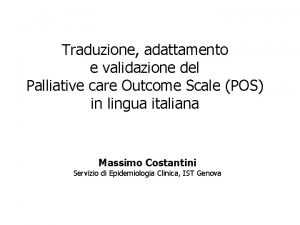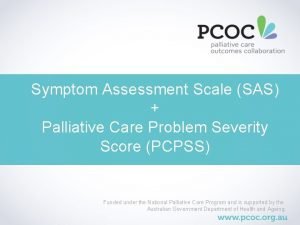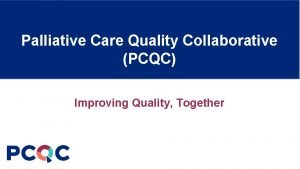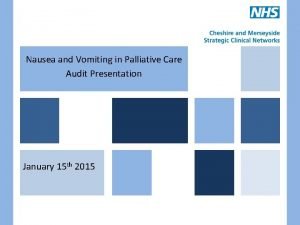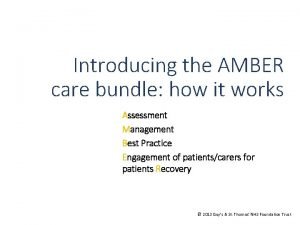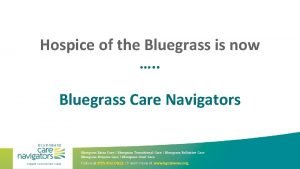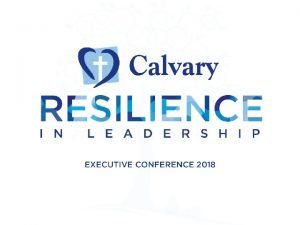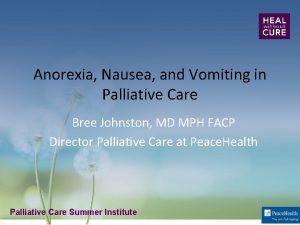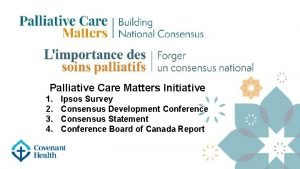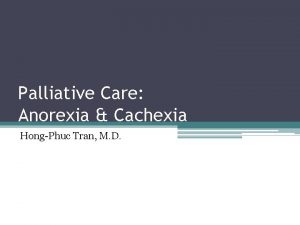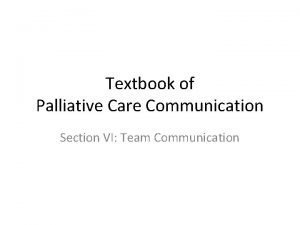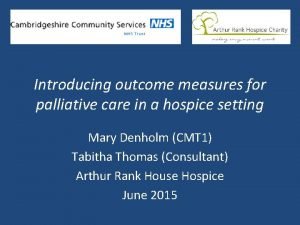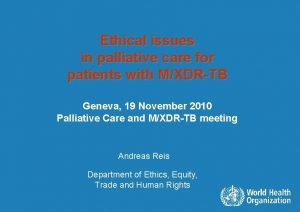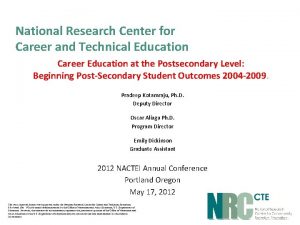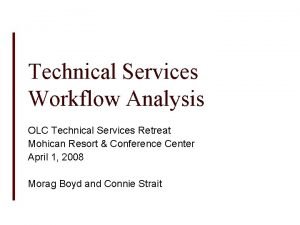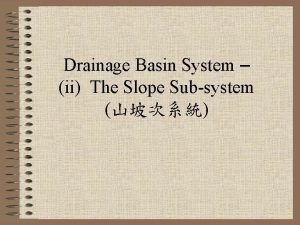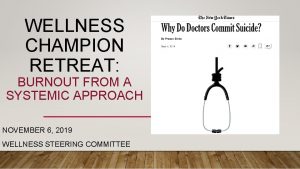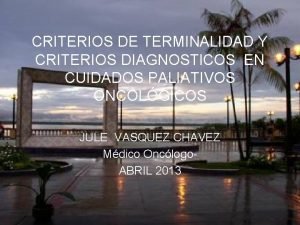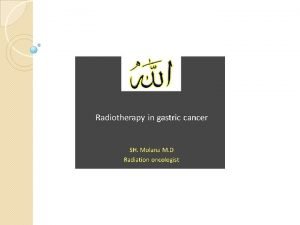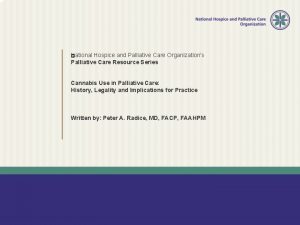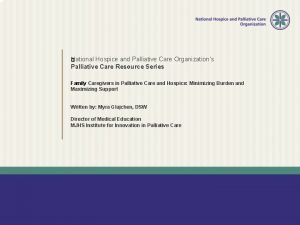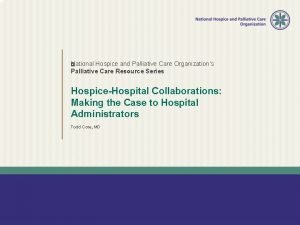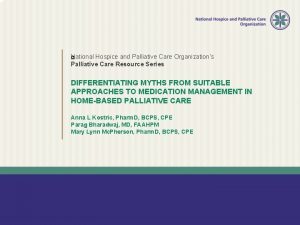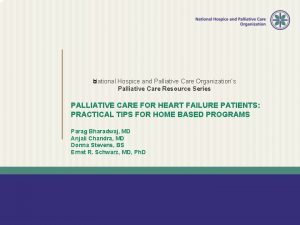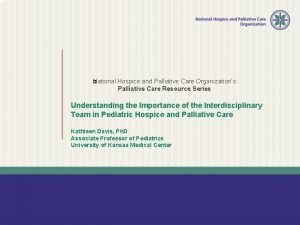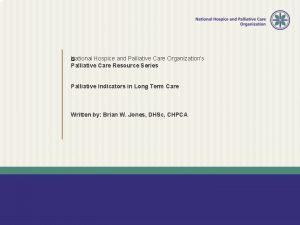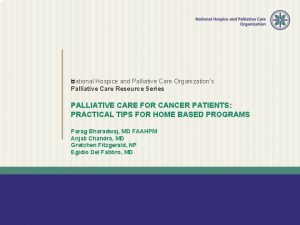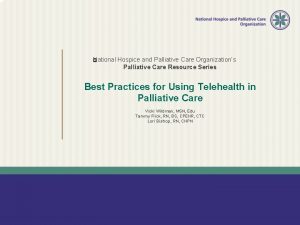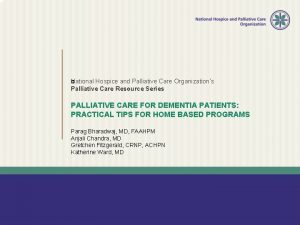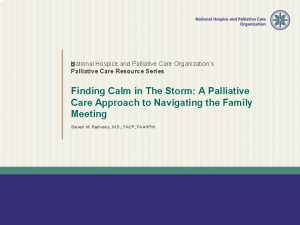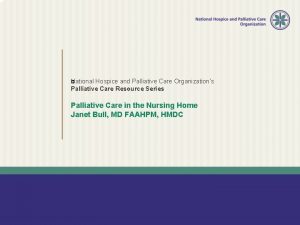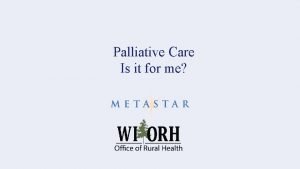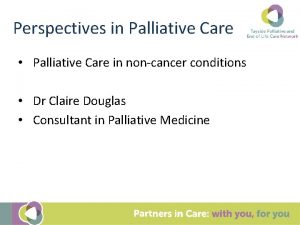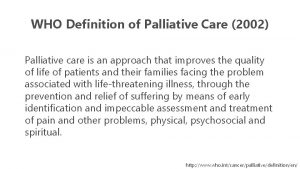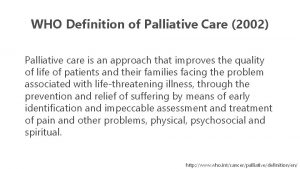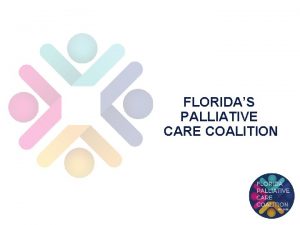National Palliative Care Research Center Retreat NPCRC A

















































- Slides: 49

National Palliative Care Research Center Retreat (NPCRC) • A collaborative meeting jointly sponsored by the NPCRC, the American Cancer Society, and the College of Palliative Care

Goals For Our Retreat To provide an opportunity for interdisciplinary palliative care researchers to come together to network, learn from each other, discuss the science of palliative care, and develop new research ideas and collaborations.

Objectives • Review our accomplishments in palliative care • Place our work in the national context • Understand why the NPCRC was formed and what it is about • Get a sense of who else is at this meeting • Preview the content of the next 2 1/2 days

Our Vision of Palliative Care Disease Modifying Therapy Curative, or restorative intent Diagnosis Palliative Care Life Closure Hospice Death & Bereavement NHWG; Adapted from work of the Canadian Palliative Care Association & Frank Ferris, MD

What is palliative care?

It’s not about death and dying. . . • Project on Death in America – Soros’s OSI initiative to fund palliative care initiatives • Promoting Excellence in End-of-Life Care – RWJ initiative to support research/education in palliative care • On our own terms: Moyers on Dying – 8 hour PBS series • Last Acts – RWJF consumer advocacy organization • Approaching Death: Improving care at the end of life – Institute of Medicine report • Books: – “Handbook for Mortals”, “Dying Well”, “The Good Death”

…People have an abiding desire not to be dead “I don’t want to achieve immortality through my work. I’d rather achieve it by not dying. ” Woody Allen

Language matters: The wrong language can drive our audience away • If our goal is to provide a patient-centered approach to improving care of seriously ill…the major barrier we face is self-imposed. • Many people who need palliative care not dying. Even among the subset that are, no-one wants to die, and very few are able to accept that they are dying until death is imminent. • Use of end of life, dying, and bereavement language renders our services immediately irrelevant to 95% of our audience. • If we want to reach the patients and families who need us we cannot force them to 1 st agree that they are dying. Solution- decouple palliative care from end of life care.

Definition of Palliative Care Palliative care is an interdisciplinary specialty that aims to relieve suffering and improve quality of life for patients with advanced illness, and their families. It is provided simultaneously with all other appropriate medical treatment.

Putting palliative care in context • Where did we come from • Where are we now • Where are we going

Palliative care. Predisposing environmental factors • • • Aging population, chronic disease demographics Payment system mismatch to need Isolation of hospice from mainstream medicine AIDS epidemic early 1980 s Quinlan, Cruzan, and later, Schiavo We have a quality problem: Kevorkian 1990; SUPPORT 1995; Oregon 1997. Moyers On Our Own Terms, popular media 2000 Private sector investment: RWJF, PDIA >$250 million Baby boomers with authority/leadership positions in healthcare Baby boomers with aging parents Healthcare cost emergency …

The State of the Field • • • Hospital palliative care programs: 1, 240 ABHPM certified MDs: 2, 100 HPNA certified nurses: 15, 133 Medicare certified hospices: 4, 160 Hospice patients/year: 1. 2 million – % of total U. S. deaths: 30%

Growth of Hospital Palliative Care Programs 2000 -2005 Morrison et al, J Palliat Med 2005

Growth in Palliative Care • 30% of all U. S. hospitals report a PC program • 70% U. S. hospitals with >250 beds report a Palliative Care program • ~ 100% penetration in VA hospitals • Lowest growth rate and prevalence of PC is in southern states and in for-profit hospital systems • Factors significantly associated with PC include size (+), teaching hospital (+), hospice affiliation (+), location, and for-profit status (-). Morrison et al, J Palliat Med 2005

Media Highlights This Year Print: • USA Today “Palliative workers team up to ease the pain” 04/26/07 • The New York Times “New options (and risks) in home care for the elderly” 03/01/07 • The Chicago Tribune “Where to go when pain won’t quit” 02/18/07 • The New York Times “A chance to pick hospice, and then still hope to live” 02/10/07 • Los Angeles Times “Life on her terms: Like Art Buchwald…” 02/05/07 • Newsweek “Fixing America’s Hospitals” 10/09/06 Total Print Highlights Reach: >14, 569, 278

“No institution is doing everything right. But we found 10 that are using innovation, hard work and imagination to improve care, reduce errors and save money. Determined people. . . are transforming the way U. S. hospitals care for the most seriously ill patients. The engine of change is palliative medicine. ‘The field is growing because it pays attention to the details, ’ says Dr. Philip Santa-Emma … ‘It acknowledges that even if we can’t fix the disease, we can still take wonderful care of patients and their families’. ” Newsweek Fixing America’s Hospital Crisis October 9, 2006 http: //www. msnbc. msn. com/id/15175919/site/newsweek/

Education: New Initiatives 1. Year-Long Mentoring and CPC Scholars Program: College of Palliative Care Chair: Jean Kutner, MD MSPH Council: Diane Meier, Mercedes Bern-Klug, Susan Block, Betty Ferrell, Betty Kramer, Susan Le. Grand, Deborah Sherman, James Tulsky; Ex-officio –Judy Lentz, J. Cameron Muir, Steve Smith, Porter Storey 2. Undergraduate medical education: RWJ PI: David Weissman MD (+Quill, Block) Competitive RFA for 6 medical schools to integrate undergraduate medical education into clinical palliative care services

Education: New Initiatives 3. Clinical Scholars Program: AAHPM Physician mid-career training program 8 centers of excellence selected to provide 40 -120 hours of clinical training followed by a year-long mentoring program Capital Hospice, Hospice of the Bluegrass, Medical College of Wisconsin, Midwest Palliative & Hospice Care Center, San Diego Hospice & Palliative Care, Stanford University/VA Palo Alto Hospice and HPC Program, University of Alabama at Birmingham/VA Medical Center Palliative Care Program, University of Pittsburgh Institute to Enhance Palliative Care 4. Level II (Advanced) Seminars for Growth and Sustainability for Palliative Care Programs: CAPC Seminar series focused on assisting established PC programs

Quality Guidelines: The United Front National Consensus Project on Quality Palliative Care: Essential Elements and Best Practices Established consensus guidelines for palliative care clinical programs with NHPCO, HPNA, AAHPM, CAPC, 2004 (Chairs: Betty Ferrell and Diane Meier) • www. nationalconsensusproject. org • Dissemination phase 2004 -present • Funding: RWJ and AVD Foundations

Quality Guidelines: The National Quality Forum A National Framework and Preferred Practices for Quality Palliative and Hospice Care Based on NCP & a new advisory panel Framework released February 2007. www. qualityforum. org http: //216. 122. 138. 39/publications/reports/palliative. asp 38 Preferred Practices within 8 Domains

National Quality Forum Impact of Preferred Practices • NQF links best practices in healthcare to reimbursement • NQF imprimatur very important to Medpac and policy/payers • Provides clear guidelines (a “Framework”) on what a program should look like • Implications for palliative care competencies and program development, certification, accreditation • BUT: No performance our outcome measures because of the lack of an evidence base

Coming soon… • • Joint Commission Palliative Care Certification Similar to programs for diabetes and stroke care Approved by the JC Board in November 2006 Certificate Program start 2008 Hospital leadership message –palliative care contributes to reputation for national excellence. • Operationalizes NQF Framework • Voluntary – not (yet) an accreditation requirement • Implications: – The Joint Commission says that this is important: Incentive for hospitals to start programs

Growth of Palliative Care • Dramatic increase in clinical programs • Growth and maturation of professional membership organizations • Sub-specialty status for physicians • Major quality and policy initiatives

But… • Lack of a solid evidence base to guide clinical care – Pain, symptoms, bereavement • Lack of health services research to guide delivery of care – Hospitals, Hospice, Ambulatory Care – Cancer, COPD, CHF, AD • Lack of basic science research that will lead to new treatment modalities – Symptoms, Resilience, Prolonged Grief Disorder

Without Research… • Specialty without solid clinical foundation – High on the arrogance/ignorance axis • Specialty without an academic platform – Academic Departments do not exist without research • No “R” dollars, No teaching platform • Specialty without credibility/power at NIH, IOM, AAMC

Status of Palliative Care Research

Palliative Medicine Research Funding • Aims: – To identify sources of funding for palliative care research published from 2003 -2005 – To examine NIH funding of palliative care research from 2001 -2005 Gelfman LP, Morrison RS. J Palliat Med, In press

Palliative Medicine Research Funding: Methods • Investigator Identification – Reviewed all research articles published from 2001 -2005 in palliative care (PC), major general medicine journals, and relevant subspecialty journals and abstracted names of first and last author – Abstracted names of editorial board members of PC journals – Searched Pub-Med (2001 -2005) using key words and MESH terms “palliative Care”, “end-of-life care”, “hospice” and “end-of-life” and abstracted the first and last authors’ names from identified articles Collected names of all PDIA Faculty Scholars. – • • All abstracted names submitted to NIH who cross-matched names against funded grant proposals. Other funding sources determined by abstracting funding information from all articles identified in search and searching relevant VA, foundation, and industry websites. Gelfman LP, Morrison RS. J Palliat Med, In press

Palliative Medicine Research Publications & Funding (2003 -2005) Gelfman LP, Morrison RS. J Palliat Med, In press

Palliative Care Publications: 2007

NIH Funding for Palliative Care (20012005) • 109 of the 2, 212 names submitted were identified as PIs on 418 awards • NIH Award Types: – 69 (17%) grants were career development awards • 44 to junior investigators • 17 to mid-career/senior investigators • 8 to investigators whose status couldn’t be determined – 275 (66%) were research awards (80% R 01 s, 20% R 21/R 03 s) – 49 (12%) were education awards – 25 (5%) represented other funding mechanisms. Gelfman LP, Morrison RS. J Palliat Med, In press

NIH Funding for Palliative Care (20012005) • Funding by NIH Institutes: – 189 (45%) were funded by NCI (0. 4% of all NCI grants) – 94 (22%) by NINR (3% of all NINR grants) – 74 (18%) by NIA (0. 5% of all NIA grants) – 21 (5%) by NIMH (0. 1% of all NIMH grants) – 40 (10%) were funded by 8 other Institutes/Centers. Gelfman LP, Morrison RS. J Palliat Med, In press

Palliative Care Research • Well documented need for increased palliative care evidence base and palliative care research – • Reports from IOM (4), AAHPM research task force, NIH State of the Science Conference (2) Barriers: – Lack of research funding • – – Federal budget cuts combined withdrawal of major foundation support for palliative care have resulted in a withdrawal rather than an increase in support for palliative care research. Lack of Investigators (junior, mid-career, senior) Lack of Mentors

National Palliative Care Research Center (www. npcrc. org) • Center developed in response to the: – Shortage of palliative care funding structures; – Shortage of palliative care investigators; – Need for a national organizational home for palliative care research. • Primary mission is to improve quality of care for patients with serious illness and the needs of their caregivers by promoting palliative care research and translating research results into clinical practice.

Funders • Emily Davie and Joseph S. Kornfeld Foundation • The Brookdale Foundation • The Olive Branch Foundation

NPCRC Areas of Focus • Exploring the relationship of pain and other distressing symptoms on quality and quantity of life, independence, function, and disability and developing interventions directed at their treatment in patients with advanced and chronic illnesses of all types; • Studying methods of improving communication between adults living with serious illness with their families and their health care providers; • Evaluating models and systems of care for patients living with advanced illness and their families under the current reimbursement structure.

NPCRC Activities • Pilot/Exploratory Grants – Goal is to provide experienced investigators with pilot/exploratory data that will support larger NIH/VA/Foundation (e. g, ACS) funded research grant • Junior Investigator Career Development Awards – Goal is to provide 2 years of protected time for junior investigators in palliative care • Annual Research Retreat and Symposium

What will the next 2 1/2 days hold?

Who is in the room? • NPCRC – CDA grantees and their mentors – P/E grantees – Scientific Advisory Committee and Scientific Review Committee Members • American Cancer Society – Grantees – Program Directors • College of Palliative Care – Scholars – Council members • Funders and Supporters • 18 RNs, 7 SW, 25 MD, 9 other (psychology, health services research, behavioural medicine), and 2 JDs 16 Junior investigators, 39 Experienced investigators •

NPCRC Initiatives (2006 -2007) • First RFA 2006 -2007 (6 awards in total) • Pilot exploratory projects – Investigators performing pilot/exploratory research studies that focus on improving care for seriously ill patients and their families. – Projects must test interventions, develop research methodologies, and explore novel areas of research that related to the Center's core mission – Projects require a clearly defined plan as to how the results will be used to develop larger, extramurally funded research projects. – Response: • Received 73 LOI, 54/62 eligible applications submitted for review • 3 funded • Career Development Awards – Designed to provide junior faculty with 2 years of protected mentored research time to develop their academic careers • Received 28 LOI, 19/21 eligible applications submitted for review • 3 awarded (2 NPCRC funded, 1 subsequently funded as a K 23 award)

ACS Palliative Care Pilot Grant Initiative • $500 K/year for 5 years to support pilot/exploratory projects in palliative care • First RFA 2006 -2007 – 146 applications received • 5 funded from the RFA • 2 subsequently funded through local chapters – 5 proposals jointly submitted to NPCRC

CPC Scholars Program • Provides funding for US-based physicians, nurses, and social workers to participate in this retreat – Intended for individuals who are or will soon be applying for a K award or other career development award. – Priority given to applicants who have a demonstrated commitment to an independent palliative care research career • College received 31 applications • 12 Scholars funded to attend this retreat – 2 MD, 5 RN, 5 SW

In Summary…. • Pilot Exploratory Grants: 214 unique applicants, 10 awarded (5%) • Junior Faculty: 21 unique applicants, 3 awarded (14%) • ACS/NPCRC/CPC: 266 applicants, 25 awarded (9%) • NPCRC goal is to raise sufficient funds to double our grant offerings and to develop alternative funding sources through collaborations with other organizations like ACS

Our Schedule…

Tonight • 5: 30 -6: 30 pm: Wine and cheese reception • 6: 30 – 9: 00 pm: Dinner with grantee poster presentations – ACS, NPCRC, CPC funded projects

Tuesday • 9: 00 – 10: 30 am: A Program of Quality of Life and Palliative Care: Twenty Three Years of Failure, Error, Mishaps, and Disaster (Ferrell) – Presentation and discussion • 10: 45 am – 12: 15 pm: Concurrent Research in Progress presentations (4 Groups) • 12: 30 – 2: 00 pm: The Third Way: Working with foundations, organizations, and philanthropists (Elk, List, Meier) – Presentation, discussion, & lunch • 2: 00 – 6: 00 pm: Networking/Free Time • 6: 00 – 7: 30 pm: Dinner • 8: 00 – 9: 30 pm: Concurrent Didactic Sessions (2 Groups) – Developing a Program of Research: Challenges, Problem Solving, and Solutions (Experienced investigators) – Introduction to the NIH Process and a Mock Study Section (Junior Investigators)

Wednesday • 8: 00 – 9: 00 am: Breakfast • 9: 00 – 10: 30 am: Concurrent Small Group Research Discussions (3 Groups) – Pain and symptom research – Communication research – Health services research • 10: 45 am – 12: 15 pm: Concurrent Discipline Specific Small Group Discussions (Medicine, Nursing Social Work) • 12: 15 – 1: 30 pm: “Where do people want to die? ” (Addington-Hall) – Closing presentation and lunch

www. npcrc. org Thank you!

Comments Questions Discussion
 National palliative care research center
National palliative care research center Palliative care versus hospice care
Palliative care versus hospice care Palliative care programme
Palliative care programme Rug adl assessment
Rug adl assessment Hospice satisfaction survey
Hospice satisfaction survey Principles of palliative care
Principles of palliative care Palliative care in nepal
Palliative care in nepal Palliative care assistant
Palliative care assistant European certificate in palliative care
European certificate in palliative care Parallel planning palliative care
Parallel planning palliative care Franciscan hospice and palliative care
Franciscan hospice and palliative care Outcome measures traduzione
Outcome measures traduzione Palliative care problem severity score
Palliative care problem severity score Palliative care quality collaborative
Palliative care quality collaborative Antiemetic drugs classification
Antiemetic drugs classification Just in case bag palliative care
Just in case bag palliative care Amber palliative care
Amber palliative care Goscote palliative care centre
Goscote palliative care centre Barry laird
Barry laird Bluegrass palliative care
Bluegrass palliative care Calvary palliative care
Calvary palliative care Anorexia, nausea and vomiting
Anorexia, nausea and vomiting Palliative care matters
Palliative care matters Anorexia cachexia palliative care
Anorexia cachexia palliative care Goc palliative care
Goc palliative care European delirium association
European delirium association Epeco
Epeco Textbook of palliative care communication
Textbook of palliative care communication Oacc palliative care
Oacc palliative care Ethical issues in palliative care
Ethical issues in palliative care Primary secondary tertiary medical care
Primary secondary tertiary medical care National center for scientific research demokritos
National center for scientific research demokritos National research center for career and technical education
National research center for career and technical education National research center kurchatov institute
National research center kurchatov institute National research center kurchatov institute
National research center kurchatov institute Metode dribble dengan berhenti sementara sambil menjaga
Metode dribble dengan berhenti sementara sambil menjaga Olc technical services retreat
Olc technical services retreat Retreat at rtp
Retreat at rtp Gst 101 form
Gst 101 form Slope decline and slope retreat
Slope decline and slope retreat Vipassana 10 day silent retreat substance abuse
Vipassana 10 day silent retreat substance abuse Physician burnout retreat
Physician burnout retreat With the order reversed perversely crossword clue
With the order reversed perversely crossword clue Synthesis plural
Synthesis plural Envy in the masque of the red death
Envy in the masque of the red death Whose conscience is his strong retreat
Whose conscience is his strong retreat Pps scale hospice
Pps scale hospice Palliative performance scale
Palliative performance scale Adjuvant neoadjuvant palliative
Adjuvant neoadjuvant palliative Nucot cos'è
Nucot cos'è
